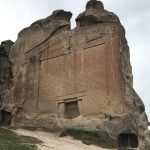Who exactly the Urartians were and where they came from remains uncertain although they seem to have replaced a people known as the Hurrians who had developed a kingdom called Mitanni in the same area. Luckily, the names of the kings of Urartu are known from the many inscriptions that they left behind. It’s also known that their earliest power struggles were mainly with the neighbouring Assyrians although ultimately they were overthrown by a combination of invading Cimmerians, Scythians and Medes. The whys and wherefores remain something of a mystery but ultimately much of Urartu was absorbed into the Kingdom of Armenia; most historians seem to agree that the last of the Urartians should be identified as proto-Armenians.
The Urartians had their own language which was written in Assyrian cuneiform and in other hieroglyphic forms that are yet to be translated. They worshipped almost a hundred different gods, with the main deity being the warrior Khaldi who is usually depicted standing on a lion. They also worshipped a thunder god named Theispas who appears to be the same as the Hittite god Teshuba. Great farmers who made much use of irrigation ditches, the Urartians were also wonderful metal workers who used the lost-wax process to make moulds for their beautiful cauldrons and axes.
Van Kalesi (Van Castle, Rock of Van)
The single most impressive reminder of the Urartians to survive in Turkey is Van Castle, often called the Rock of Van because of its location on top of a 1.5-kilometre-long ridge of rock that lies due west of the town centre close to Lake Van. One hundred metres above sea level King Sardur I (844-828) had a fortress built here that continued in use right into modern times. Unfortunately recent restoration cannot be said to have improved the appearance of the ruins.
Today’s visitors usually skirt the base of the rock on its northern side to reach the ticket booth. In doing so they bypass a small Ottoman mosque and tomb complex behind which the remains of a Urartian temple to Khaldi are cut into the base of the rock close to the tomb of King Sardur II (753-735). Even today this part of the rock is believed to retain a certain power, with infertile women coming here to pray for children.
From the ticket booth you ascend the rock and eventually find yourself inside the walls. Some of the structures on the summit were installed much later than the Urartian period (not least the image of Atatürk) but the one truly unmissable sight is on the southern side of the rock where the tomb of King Argishti I (785-753) is cut right into it and must be approached via a flight of weathered steps. There a huge cuneiform inscription extols his life and works.
Many other tombs were cut into the Rock of Van and can be accessed although all were long ago robbed of their contents. On the south side of the Rock it’s also worth looking out for a trilingual inscription in Persian, Babylonian and Medean that records the deeds of the fifth century BC Persian king Xerxes. It was transcribed by the archaeologist Friedrich Eduard Schultz who dangled from a rope to carry out the task in 1827.
Çavuştepe
The archaeological site at Çavuştepe is to the right of the road as you head southeast from Van to Hakkari. Here King Sardur II built himself a palace, this time on a ridge of rock overlooking the Gürpınar plain. The walls were built of giant blocks of andesite that fitted together so well that no mortar was needed to join them although only the lowest levels now survive.
There are several specific things to look out for at Çavuştepe, including giant pithoi (jugs) that were embedded in the ground to serve as storage units as well as the remains of another temple to Khaldi with a fine cuneiform inscription. You can also gaze down onto one of the Urartian irrigation ditches; known as the Semiramis Canal, it’s still in use today. Most visitors, however, will probably be most struck by the remains, at the far end of the ridge, of what must be one of the earliest squat toilets in existence.
Caretaker Mehmet Kuşman is one of the world’s few experts in the Urartian language. If you’re lucky enough to find him on site he will translate the temple inscription for you.
Ayarış Kalesi
Almost impossible to reach by public transport, the remains of the Ayarış Kalesi (castle) nevertheless stand in a stunning location overlooking a strip of sandy beach beside an undeveloped part of Lake Van. The castle was built during the reign of King Rusa II (685-45 BC) and once again contains a temple complete with cuneiform inscription. Should you be lucky enough to visit in late summer when archaeologists are working at the site you might be able to see some of the interior decoration, which featured carvings of lions and griffins. Few people make it here so you will probably have the site to yourself.
Toprakkale
Tushpa was eventually replaced as the Urartian capital in the reign of King Rusa II by Rusahinili, identified as Toprakkale, north of Van, where remains of another Urartian fortress complete with temple to Khaldi have been identified. Some of the finds from the site are now in the Hermitage Museum in St Petersburg.
